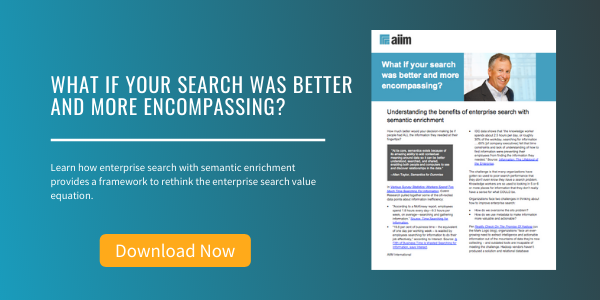
15 Trends You Need to Know about Enterprise Search
The popularity of the term “knowledge worker” comes and goes, but the single most-important characteristic of such a job-description is the ability to find information, process it into knowledge, and so add value for the organization. Sounds simple, and in the age of the internet, finding and sifting information from the outside world is relatively simple and very quick. However, when it comes to information that resides inside the organization, the situation can be very different, and the effect of search efficiency on knowledge worker productivity can be huge.
Below are the key data points drawn from AIIM's research study of information professionals - Search and Discovery: Exploiting Knowledge, Minimizing Risk.
-
For 71% of the organizations polled, search is vital or essential, yet only 18% have cross-repository search capabilities. 58% show little or no sign of search maturity.
-
75% of respondents would not disagree that information is easier to find outside of the organization than within. 65% agree that employees struggle to access internal information from mobile devices. Only 39% have natural language search.
-
Improved search is a priority over big data/content analytics for 73%. There is some movement (19%) towards a unified search and big data strategy (although 59% have no big data strategy).
-
The IT Department takes responsibility for search in 52% of organizations, although only 25% feel it should be so. 44% feel RM/Compliance/IG would be a better owner, although there is also strong support for the concept of a Head of Knowledge Management (34%) or Chief Knowledge Officer (29%).
-
25% have no advanced or dedicated search tools. 13% have five or more.
-
Those with advanced search tools are most likely (45%) to acquire them through their ECM product or provider. 42% of users have on-server search products outside of ECM, including 14% using Open Source. 21% are using a dedicated search appliance, and 8% SaaS.
-
38% have not tuned or optimized their search tool at all, including 8% who have not even switched it on. Half of the responding organizations allocate less than half an FTE to support search applications. Only 12% have used external expertise.
-
Beyond SharePoint, intranet, and ECM systems, most content is beyond the scope of the search tools. Only 19% have advanced search across email, with less than 10% extending to other enterprise systems.
-
47% feel that universal search and compliant e-discovery is becoming near impossible given the proliferation of cloud share and collaboration apps, personal note systems, and mobile devices. 60% are firm of the view that automated analytics tools are the only way to improve classification and tagging to make their content more findable.
-
Better decision-making and faster customer service are given as the top benefits from improved search tools. Only 14% were required to make a financial business case for search investment.
-
42% consider that they have achieved payback from their investment in search tools within 12 months or less. 62% achieved payback within 18 months.
-
53% of respondents agree that their legal discovery procedures are “ad hoc, manual, disruptive, and expensive.” 28% have no policy, process, or precedent for legal discovery and legal hold.
-
29% rely on instructions not to delete, rather than more robust hold procedures. 47% admit that their email retention and hold policies expose them to risk
-
74% rely on manual processes to manage the downstream legal discovery process. 10% have dedicated legal-case products, and 9% have a discovery workflow as part of ECM.
-
On the whole, users are likely to increase spend on all aspects of search and discovery in the next 12 months, in particular, content analytics, mobile device apps, and consolidation of multiple search tools.
A note on the sample -- 415 individual members of the AIIM community took the survey between Jul 11 and Aug 02, 2014, using a Web-based tool. Invitations to take the survey were sent via email to a selection of the 80,000 AIIM community members. Survey respondents represent organizations of all sizes. Larger organizations over 5,000 employees represent 30%, with mid-sized organizations of 500 to 5,000 employees at 35%. Small-to mid sized organizations with 10 to 500 employees constitute 35%. Respondents from organizations with less than 10 employees and suppliers of ECM products and services have been eliminated from the results, taking the total to 353 respondents.
About John Mancini
John Mancini is the President of Content Results, LLC and the Past President of AIIM. He is a well-known author, speaker, and advisor on information management, digital transformation and intelligent automation. John is a frequent keynote speaker and author of more than 30 eBooks on a variety of topics. He can be found on Twitter, LinkedIn and Facebook as jmancini77. Recent keynote topics include: The Stairway to Digital Transformation Navigating Disruptive Waters — 4 Things You Need to Know to Build Your Digital Transformation Strategy Getting Ahead of the Digital Transformation Curve Viewing Information Management Through a New Lens Digital Disruption: 6 Strategies to Avoid Being “Blockbustered” Specialties: Keynote speaker and writer on AI, RPA, intelligent Information Management, Intelligent Automation and Digital Transformation. Consensus-building with Boards to create strategic focus, action, and accountability. Extensive public speaking and public relations work Conversant and experienced in major technology issues and trends. Expert on inbound and content marketing, particularly in an association environment and on the Hubspot platform. John is a Phi Beta Kappa graduate of the College of William and Mary, and holds an M.A. in Public Policy from the Woodrow Wilson School at Princeton University.



